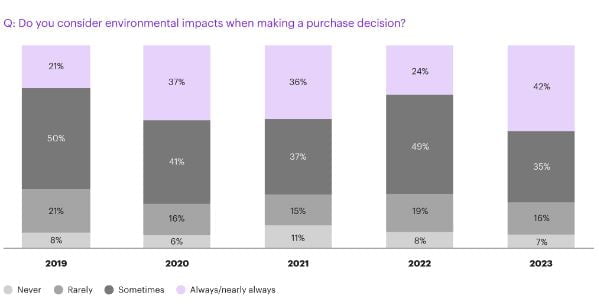Corey Chafin, Moritz Breuninger, Erika Stewart & Christina Carlson, authors of the Kearney report, alert that “Inflation is temporary, climavorism is not. Don’t get distracted”
Despite ongoing food price inflation and related economic pressures, American consumers are considering the environmental impacts of their food choices more than ever, suggesting climavores are just getting started and higher costs won’t distract them from their mission
Climavorism—defined as actively making food choices based on climate impacts with the intent to benefit the planet—is a growing concept and lifestyle.
Kearney’s 2023 Earth Day survey of 1,000 US consumers saw awareness of the environmental impacts of their food choices significantly increase since our last survey. Moreover, we found that higher awareness is driving food selection at the shelf and case level. Figure 1 shows that 42 percent of 2023 respondents reported always or nearly always considering environmental impacts when making a purchasing decision, a historic high and an 18 percentage point increase over 2022. This is a clear signal that our observation last year that climavorism was growing from the “consumer fringe” to the heart of the mass market is becoming a reality.
Moving from head to plate
When it comes to food, taste and cost are king. Since it isn’t as much about what you eat as it is about why you make the food choices, climavores can be vegans, vegetarians, or omnivores. Chickens have a lower carbon imprint than cattle do, so the decision by consumers to eat less beef and more poultry in order to help the environment is a good example of climavorism in action.
One way to validate that climavorism has gone mainstream is to see how it’s been impacted by inflation. Over the past year, US consumers have seen food prices rise by 10 percent, with items such as eggs increasing by as much as 32 percent. And, while there are signs inflation is beginning to ease, it’s reasonable to assume food prices won’t drop dramatically, at least in the near term. The question then is whether or not climavorism is a discretionary spending behavior, something whose enthusiasm levels fluctuate by economic cycles. Our 2023 Earth Day survey found the opposite is true; consumers are taking this year’s Earth Day theme “Invest in Our Planet” quite literally.
As we said earlier, taste and price have always been, and will always be, key factors in consumer purchasing decisions. But, when it comes to price, as shown in figure 2, the research supporting Kearney’s 2023 Earth Day survey shows it is decreasing as a barrier to purchasing products claiming environmental benefits, despite persistent inflation across food categories.
The data suggests the growth of climavorism is inflation-resistant and should continue. In fact, one might argue that higher prices can also aid consumers in making climate-friendly choices, such as substituting more expensive beef with more affordable chicken. Regardless, we have reason to believe we will see a step change in the adoption of climavorism as a lifestyle that impacts food choices, leading to transformational change across the entire food system. But will this change be voluntary or forced and—in either case—who will drive it?
To address this question, Kearney has created four scenarios describing plausible futures where climate-conscious food choices have become mainstream. The intent of these models is to explore possibilities, not predict what will actually happen. Of course markets don’t exist in a vacuum, but are the product of the dynamic interactions of all four of the drivers we are going to look at—consumers, regulators, manufacturers, and Earth itself. Each of our scenarios will treat one of these four market elements as the primary driver.
The report follows analyzing four scenarios for the rapid adoption of climavorism. Acceso to the complete notice, below.
The picture, Fig. 1 of the original report, shows that the environmental impact os playing an increasingly important role in purchasing decisions. The figure shows the answers to the question “do you consider environmental impacts when making a purchase decision? The percentage of those who responded that they always or almost always grew from 21% in 2019 to 42% in 2023.
Kearney, Four scenarios for the rapid adoption of climavorism











